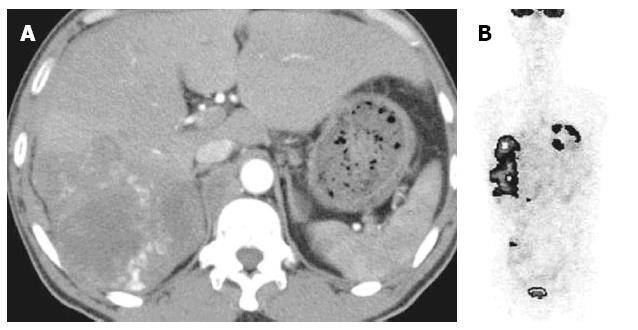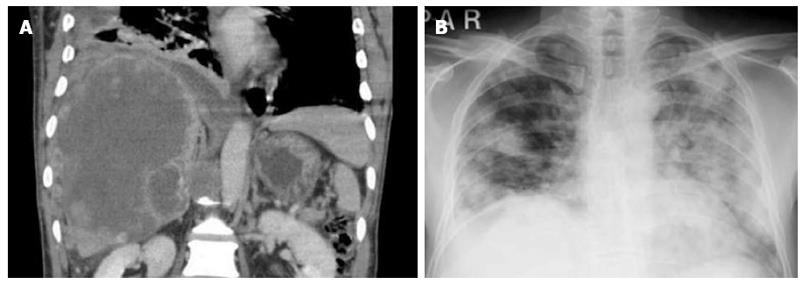Copyright
©2013 Baishideng Publishing Group Co.
World J Gastroenterol. Dec 28, 2013; 19(48): 9485-9489
Published online Dec 28, 2013. doi: 10.3748/wjg.v19.i48.9485
Published online Dec 28, 2013. doi: 10.3748/wjg.v19.i48.9485
Figure 1 Enhanced computed tomography of the liver and fludeoxyglucose-positron emission tomography.
A: Enhanced computed tomography showed a multi-nodular tumor in the right lobe of the liver; B: Fludeoxyglucose-positron emission tomography scan showed accumulation in the liver with no accumulation in the testes.
Figure 2 Computed tomography and chest X-ray following ruptured of the tumors with respiratory failure.
A: Computed tomography scan following rupture of the tumors showed an enlarged tumor with ascites and a right pleural effusion; B: Chest X-ray showed multiple lung metastases clinically associated with severe respiratory failure.
Figure 3 Photomicrographs of the liver tumor.
A: Ovoid mononuclear cytotrophoblast cells (long arrow) encircled by large amorphous multinuclear syncytiotrophoblast cells (short arrows) among dark-red hemorrhagic tissue (hematoxylin and eosin, × 400); B: Immunohistochemical stain showing α-human chorionic gonadotropin (hCG) positive cells (× 400); C: Immunohistochemical stain showing β-hCG positive syncytiotrophoblast cells (× 400).
- Citation: Sekine R, Hyodo M, Kojima M, Meguro Y, Suzuki A, Yokoyama T, Lefor AT, Hirota N. Primary hepatic choriocarcinoma in a 49-year-old man: Report of a case. World J Gastroenterol 2013; 19(48): 9485-9489
- URL: https://www.wjgnet.com/1007-9327/full/v19/i48/9485.htm
- DOI: https://dx.doi.org/10.3748/wjg.v19.i48.9485















